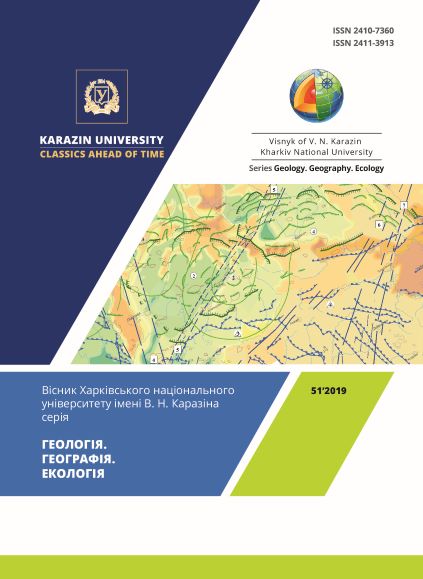Дослідження можливості використання Ceriodaphnia affinis Lilljeborg (Crustacea) у короткостроковому випробуванні при встановленні екологічних стандартів якості води в Україні
DOI:
https://doi.org/10.26565/2410-7360-2019-51-14Ключові слова:
поверхневі води, токсичність, хімічні речовини, ефективна концентрація, Ceriodaphnia affinis Lilljeborg, метрологічні характеристикиАнотація
Аналіз функціонуючих в різних країнах систем нормування якості поверхневих вод показав, що існує тенденція використання таких нормативів, дотримання яких дозволяє захищати водну екосистему та задовольняти потреби суспільства й галузей економіки. В основу таких нормативів покладено отримання екотоксикологічної інформації небезпечної хімічної речовини на представниках водної екосистеми. Серед них одними із найбільш чутливих тест-організмів є ракоподібні з родини Daphniidae, які використовуються не тільки для встановлення норм якості води хімічних речовин, а й для оцінки якості стічних та поверхневих вод за токсикологічним показником. Для встановлення екологічних стандартів якості води в країнах ЄС рекомендується використовувати стандартизовану міжнародну методику з визначення токсичності хімічних речовин на Daphnia magna Straus (OЕСР №202), однак в Україні у водоохоронній практиці найбільш популярним тест-організмом є Ceriodaphnia affinis Lilljeborg (Daphnia sp.).
Робота спрямована на дослідження можливості використання Ceriodaphnia affinis Lilljeborg (Daphnia sp.) у короткостроковому випробуванні при встановленні екологічних стандартів води в Україні. У результаті проведених експериментальних досліджень на культурі ракоподібних з колекції культур лабораторії еколого-токсикологічних досліджень ХНУ імені В. Н. Каразіна за умов використання методики OЕСР №202 було встановлено метрологічні характеристики: діапазон реагування тест-організмів Ceriodaphnia affinis наступний – 1,45 < ЕС50-24 < 2,91 (мг/дм3); похибка результатів визначення токсичності хімічної речовини - 0,34 мг/дм3 (31,6 %); відтворюваність результатів визначення токсичності хімічної речовини – 0,18 мг/дм3 (16,1 %); норматив оперативного контролю – 0,49 мг/дм3. Коефіцієнт варіації визначених на Ceriodaphnia affinis ЕС50-24 та ЕС50-48 для К2Cr2O7 склав 16,8 % та 15,9 % відповідно. Отримані результати свідчать про можливість використання культури ракоподібних Ceriodaphnia affinis у короткостроковому випробуванні при встановленні екологічних стандартів якості води в Україні.
Посилання
UNESCO (2018). The United Nations World Water Development Report 2018: Nature-Based Solutions for Water. Paris. UNESCO. http://unesdoc.unesco.org/images/0026/002614/261424e.pdf
Brahinskyi L. P., Oleksiv I. T. (1995). Hidroekolohichna toksykometriia ta bioindykatsiia zabrudnen: Teoriia, metody, praktyka vykorystannia. Lviv, Svit, 440.
Directive 2000/60/EC of the European Parliament and of the Council of establishing a framework for Community action in the field of water policy (2000). https://eur-lex.europa.eu/legal-content/EN/TXT/?uri=celex:32000L0060
Vodnyi Kodeks Ukrainy vid 06.06.1985 r. № 213/95-VR. http://zakon3.rada.gov.ua/laws/show/213/95-%D0%B2%D1%80
Filenko O. F., Sokolova S. A. (1998). Metodicheskie ukazanija po ustanovleniju jekologo – rybohozjajstvennyh normativov (PDK i OBUV) zagrjaznjajushhih veshhestv dlja vody vodnyh ob"ektov, imejushhih rybohozjajstvennoe znachenie. M., VNIRO, 145.
Guidance Document № 27:Technical guidance for deriving environmental quality standards (2011). https://circabc.europa.eu/sd/a/0cc3581b-5f65-4b6f-91c6-433a1e947838/TGD-EQS%20CIS-WFD%2027%20EC%202011.pdf.
A protocol for the derivation of water quality guidelines for the protection of aquatic life (2007). Canadian Council of Ministers of the Environment, Winnipeg. http://ceqg-rcqe.ccme.ca/download/en/220.
Guidelines for Deriving Numerical National Water Quality Criteria for the Protection Of Aquatic Organisms and Their Uses. U.S. Environmental Protection Agency. https://www.epa.gov/sites/production/files/2016-02/documents/guidelines-water-quality-criteria.pdf.
Ob utverzhdenii normativov kachestva vody vodnyh ob"ektov rybohozjajstvennogo znachenija, v tom chisle normativov predel'no dopustimyh koncentracij vrednyh veshhestv v vodah vodnyh ob"ektov rybohozjajstvennogo znachenija, ot 13.01.2017 g. № 45203. https://minjust.consultant.ru/documents/22231?items=1&page=1.
Gredelj A., Barausse A., Grechi L., Palmeri L. (2018). Deriving predicted no-effect concentrations (PNECs) for emerging contaminants in the river Po, Italy, using three approaches: Assessment factor, species sensitivity distri-bution and AQUATOX ecosystem modelling. Environment International. 119, 66-78 [https://doi.org/10.1016/j.envint.2018.06.017].
Martin O. V., Adams J., Beasley A., Belangers S and other (2019). Improving environmental risk assessments of chemicals: Steps towards evidence-based ecotoxicology. Environment International. 128, 210-217 [https://doi.org/10.1016/j.envint.2019.04.053].
Gunnarsson L., Snape J. R., Verbruggen B.,Owen S. F. and other (2019) Pharmacology beyond the patient – The environmental risks of human drugs. Environment International. 129, 320-332 [https://doi.org/10.1016/j.envint.2019.04.075].
Barrick A., Châtel A., Manier N., Kalman J. and other (2019) Investigating the Impact of Manufacturing Processes on the Ecotoxicity of Carbon Nanofibers: A Multi–Aquatic Species Comparison. Environmental toxicology and chemistry. [https://doi.org/10.1002/etc.4537].
OECD (2004). Daphnia sp. Acute Immobilisation Test, OECD Guideline for the testing of chemicals,Guideline 202 [https://doi.org/10.1787/9789264069947-en].
DSTU 4173 (2003). Jakistj vody. Vyznachannja ghostroji letaljnoji toksychnosti na Daphnia magna Straus ta Ce-riodaphnia affinis Lilljeborg (Cladocera, Crustacea) (ISO 6341:1996, MOD).
DSTU 4174 (2003). Jakistj vody. Vyznachannja subletaljnoji ta khronichnoji toksychnosti khimichnykh rechovyn ta vody na Daphnia magna Straus i Ceriodaphnia affinis Lilljeborg (Cladocera, Crustacea) (ISO 1076:2000, MOD).
KND 211.1.4.055-97 (1997). Metodyka vyznachennja ghostroji letaljnoji toksychnosti vody na rakopodibnykh Ceriodaphnia affinis Lilljeborg. Zatv. nakazom Minpryrody Ukrajiny vid 21.05.97 № 68.
KND 211.1.4.046-95 (1995). Biotestuvannja ta vyznachennja rivniv ghostroji letaljnoji toksychnosti zvorotnykh vod, jaki vidvodjatjsja u vodni ob'jekty. Metodyka. Zatv. nakazom Minekobezpeky Ukrajiny vid 30.05.95 № 47.
KND 211.1.0.051-96 (1996). Atestacija metodyk biotestuvannja. Zatv. nakazom Minekobezpeky Ukrajiny vid 22.01.97 r. 9, 33.
OECD (2014). Current Approaches in the Statistical Analysis of Ecotoxicity Data. 114 [https://dx.doi.org/10.1787/9789264085275-en].
##submission.downloads##
Номер
Розділ
Ліцензія
Авторське право (c) 2020 Олексій Миколайович Крайнюков, Анастасія Вікторівна Якушева

Ця робота ліцензується відповідно до Creative Commons Attribution 4.0 International License.
Автори, які публікуються у цьому журналі, погоджуються з наступними умовами:- Автори залишають за собою право на авторство своєї роботи та передають журналу право першої публікації цієї роботи на умовах ліцензії Creative Commons Attribution License, котра дозволяє іншим особам вільно розповсюджувати опубліковану роботу з обов'язковим посиланням на авторів оригінальної роботи та першу публікацію роботи у цьому журналі.
- Автори мають право укладати самостійні додаткові угоди щодо неексклюзивного розповсюдження роботи у тому вигляді, в якому вона була опублікована цим журналом (наприклад, розміщувати роботу в електронному сховищі установи або публікувати у складі монографії), за умови збереження посилання на першу публікацію роботи у цьому журналі.
- Політика журналу дозволяє і заохочує розміщення авторами в мережі Інтернет (наприклад, у сховищах установ або на особистих веб-сайтах) рукопису роботи, як до подання цього рукопису до редакції, так і під час його редакційного опрацювання, оскільки це сприяє виникненню продуктивної наукової дискусії та позитивно позначається на оперативності та динаміці цитування опублікованої роботи (див. The Effect of Open Access).





